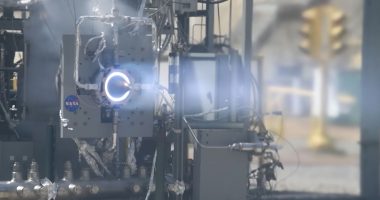
Intel Labs’s neuromorphic computing research chip, named Loihi.
Photo: Intel
Experimental computer chips that try to mimic the way human brains work could accelerate the use of voice and gesture commands in automobiles, researchers at Intel Corp. and Accenture PLC say.
The cutting-edge technique, known as neuromorphic computing, could use significantly less energy than traditional computer- and graphic-processing units that connect wirelessly to a car via the cloud. Today’s cars don’t have the AI capabilities to recognize many speech and gesture commands, in part because of the energy requirements necessary to make those functions work.
Car makers are recognizing the need for AI methods that consume less energy, which is one reason why neuromorphic computing can be beneficial, said Tim Shea, technology researcher at Accenture Labs. “They’re already running up against limitations of [current chips] not being scalable enough,” he said.
German auto maker Mercedes-Benz AG announced last week it had joined the Intel Neuromorphic Research Community to explore how neuromorphic chips could help increase energy efficiency, speed and accuracy for vehicle-related AI uses.
“With the knowledge we’ll gain, we want to achieve a significant boost for our AI applications in and around our vehicles,” said Jasmin Eichler, director of future technologies at Mercedes-Benz, in a statement.
Intel’s neuromorphic chips could begin selling commercially within five years, according to Mike Davies, director of Intel’s Neuromorphic Computing Lab.
Applications powered by neuromorphic chips inside a car could help recognize when a person is shivering and automatically adjust the temperature, Accenture Labs researchers say. They could also recognize a voice command to turn on the car or roll down the window. The chips would be integrated in the car itself and would not need to connect to the cloud in order to work.
Accenture Labs worked on a neuromorphic computing experiment this year with an undisclosed car maker. In the experiment, a neuromorphic chip made by Intel Labs, named Loihi, recognized voice commands such as “start the engine.” The chip consumed 1,000 times less power and responded 200 milliseconds faster than a standard GPU, Mr. Shea said.
Intel is among several companies, universities and startups, such as International Business Machines Corp. , SynSense and Applied Brain Research, that are studying neuromorphic computing. “The industry is looking for new ways of developing AI systems with much lower power consumptions,” said Alan Priestley, AI technologies analyst at research firm Gartner Inc.
Energy consumption is an impediment to some AI deployments. Developing a single AI model, for example, can have a carbon footprint equivalent to the lifetime emissions of five average U.S. cars, according to researchers at the University of Massachusetts, Amherst.
With neuromorphic computing, it is possible to train machine-learning models using a fraction of the data it takes to train them on traditional computing hardware. That means the models learn similarly to the way human babies learn, by seeing an image or toy once and being able to recognize it forever, The Wall Street Journal has previously reported.
The technique uses significantly less energy than today’s GPUs, which are one of the main computer chips used for AI systems, especially neural networks. Neural networks are used in speech recognition and understanding, as well as computer vision.
Another advantage of the computing technique is that it is “event-driven,” meaning it is only computing and using energy when it is activated by an event, such as a voice or gesture command. “It’s not just computing all the time in a uniform way, whether there’s activity or not,” said Alex Kass, a fellow and principal director at Accenture Labs.
Neuromorphic chips can be placed inside cars to do the computing “at the edge,” or inside the car itself, without needing to access the cloud. That means the AI functions always work, even in areas with bad connectivity, such as national forests, Accenture researchers say.
The chips are expected to be the predominant computing architecture for new, advanced forms of AI deployments by 2025, according to Gartner. By that year, Gartner predicts the technology will displace graphics-processing units.
Write to Sara Castellanos at [email protected]
Copyright ©2020 Dow Jones & Company, Inc. All Rights Reserved. 87990cbe856818d5eddac44c7b1cdeb8








